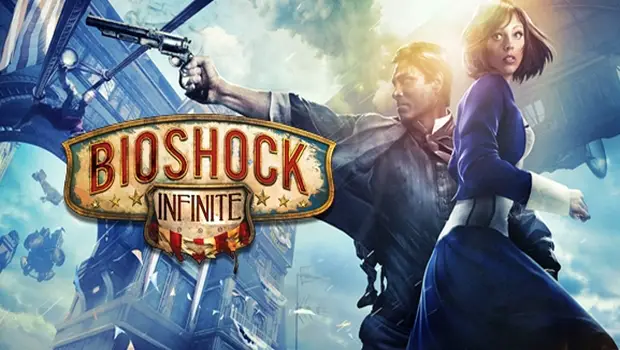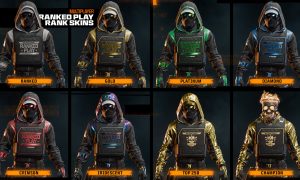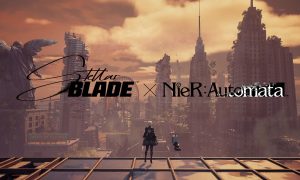
This may be one of the most difficult reviews I’ve had the pleasure to write. Those of you who have been reading my reviews for the last 15 years know that I have no trouble telling it like it is, so bad games get bad reviews. Games that were ‘almost there’ but not quite, get reviews that are ‘almost good’ but not quite, and games that were great get those hard-to-reach high-90s reviews. What do you do when you encounter a game that is nearly flawless?
There has already been a glut of reviews out for Bioshock Infinite for the PC so I decided I’d tackle the console versions. I have picked up the PC version and will make comparisons, but most of this review will focus on the Xbox 360 version and how it fares as a port. I’ll talk about how the story structure is executed, but I’m not going to spoil any of the game for you. The story of Bioshock Infinite, like its predecessors, should be experienced and not described. Rest assured, I’ll not be giving away anything beyond the first few minutes of the game and some light information on the setting.
“I can see the angels, dancing in the sky.” – Little Sister
[singlepic id=1275 w=320 h=240 float=left]Bioshock Infinite opens with the player in the water heading towards a lighthouse – the start of many little nods to the two previous titles. The game tells the story of ex-Pinkerton foot soldier Booker DeWitt and how he came to be employed to help rescue a young woman named Elizabeth. The equally familiar dystopic setting is a city called Columbia that floats in the sky, and the year is 1912. This is where the similarities (but not the connections!) to the original Bioshock titles end.
Columbia is a world teeming with life. Gone is the run-down, leaking, nearly empty hull of Rapture, now replaced by the incredible palette of a beautiful city populated by people. Folks speak in reverence of their beloved savior and leader, Prophet Comstock and how he has saved their fair city. Political, societal, and philosophical questions are debated by the denizens of the city as the sunlight streams through the soft blanket of clouds that envelopes each flying city platform. Shops running on the honor system while their employees enjoy the passing parade dot the landscape, couples hold hands and share picnics on the lawn. Others find solace in quiet prayer to the luminaries of the time on bent knee in front of large statues. This place is beautiful….until it suddenly isn’t. You very quickly find yourself directly in the middle of horrific events that I guarantee will take you by surprise, and your one last chance to make things right becomes an imperative mission not unlike what we experienced in The Walking Dead – you must save Elizabeth at all costs.
The storyline is nowhere near as straightforward as the one in the two previous Bioshock titles. A perfect triumph of horror, humor, and incredible character development come together with an amazing blend of early Americana and science fiction to create a world unlike any we’ve seen in any game ever made. Gone are the tight and dangerous quarters of Rapture, replaced by the infinite space of the city. Rooms are rarely locked behind you, giving you freedom of movement that speaks not only to the change in venue, but also has a lasting impact on the visual presentation as well as the combat of this title. The storyline serves up a healthy dose of the racism that was rampant in the early 1900s, early-American jingoism, Founding Father deification (that is still present today!), and much more. This game script does more to raise the “games as art” than anything I can recall in recent memory. While the “Atlas Shrugged”-inspired economic power struggles of Andrew Ryan were compelling, the neo-religious overtones of Zachary Hale Comstock are downright unsettling. Blockbuster movies don’t have this level of compelling script work – if only the graphics were up to the same task.[singlepic id=1277 w=320 h=240 float=right]
“We all make choices, but in the end, our choices make us.” – Andrew Ryan
Before I start in on the Xbox 360’s graphics, let me preface this by saying that this game is absolutely gorgeous. That this game is built on the Unreal 3 Engine running on hardware from 2005 is a rather amazing thing when you see just how much detail was packed into each and every space. To fit it all on a 9GB disc (the PC version is three 9GB DVDs by comparison) and still retain a relatively stable framerate is no small feat. Unfortunately, some of the game suffers for the effort at close distance – sacrifices had to be made.
Most areas of the game are nearly flawless at a reasonable distance, and without comparison to another platform, you’ll rarely notice anything is amiss. That said, some textures on the Xbox 360 version of the game are absolutely mud up close. Text becomes unreadable and the Havok engine occasionally creates some equally disturbing moments. In my Bioshock review I mentioned how the Splicers continued to twitch after being killed, which somewhat fit that context – in this case there is less leg twitching but occasionally odd facial movements. You might see some mip-mapping or low resolution textures on chalkboards or hanging street signs that will catch your eye. It is by no means an indictment against the game’s visual presentation – these are infrequent issues, but it does remind you that the PC version is by far the superior of the platforms.
The framerate in Bioshock Infinite is relatively stable. Only during the most intense of battles does the game struggle to keep up – the final battle being among them. Thankfully it’s not gameplay impacting.
[singlepic id=1285 w=320 h=240 float=left]Bioshock Infinite’s art style is striking. The early 1900 Americana artwork is present everywhere you look. The videos for your Vigors (they are essentially Plasmids from the previous games) sport the “barker” voice style complete with skinny devils with giant heads holding pitchforks being exterminated in comical ways by a dapper gentleman in a suit (sporting the slicked-down split-down-the-middle hairstyle of the time). Videos shown in the Kinetoscope are silent short films presenting various topics not unlike crackled real-world footage you might expect from the time. It is amazing how perfectly the team at Irrational has captured the iconic look and feel of this time period.
Animation was never an issue in previous Bioshock titles, and that has not changed here. Elizabeth moves in a natural way, conveying facial emotion I’ve only really seen in titles like the Uncharted series. The simple act of flipping a coin over to you is executed in such a flawless way that you’ll likely have the same out-loud surprised reaction that I did. When she wanders into a shop, leans on the counter, curiously touches items in the store, or comments on the environments, it is clear to me that making Elizabeth feel alive was a top priority here.
“No Gods Or Kings. Only Man” -Andrew Ryan
Vigors and gunplay will feel very familiar for those who have played the two previous titles. Your left trigger launches your powers at your enemies and the right trigger shoots your currently equipped weapon. Vigor selection is pared down a bit from the vast amount of Plasmids you had in Bioshock, but secondary fire on them allows you to set traps or use them in interesting new ways. Another noteworthy change is that you are only able to carry two weapons in the game. You are free to swap out any dropped weapon as you see fit (and occasionally ammunition will become an issue) but you are always limited to just two.
To help you grow your power in the game, you’ll get a chance to apply several upgrades to each weapon, and a pair of upgrades to each Vigor. This will amount to larger clip sizes, faster reloads, or increased damage as examples for weapons, and environmental or similar (no spoilers!) upgrades for your Vigors. There are two additional ways you can grow your powers; clothing and drinks.
Throughout the game you’ll find lockpicks scattered in dark corners. Elizabeth can use these to unlock optional side areas that often contain one of two things – clothing or Infusions. The drinks offer three options – the chance to increase your health bar, your shield bar, or your salts. (Salts are the ‘mana’ that powers your various Vigors) Clothing falls into four categories – hats, shirts, pants, and boots. Similar to the Vigors, different garments offer passive bonuses that can do a great many things. Some examples include setting people on fire when you strike them with a melee attack, adding damage when you leap down from a Skyline rail, stealing health from any killed enemy. Playing through the game I found these to be interesting, but ultimately forgettable. When I stumbled upon one it’d be a reminder that they were there, but after comparing and potentially swapping them out, I’d quickly forgotten them once again. The drive to find shiny clothing loot just didn’t stick here.[singlepic id=1288 w=320 h=240 float=right]
The Skyline rail is the connective veins of the world of Columbia. Sure, cities float around and occasionally connect with one another (there are charts that tell you when the cities dock, suggesting a possible early idea that time would be persistent and areas would only be accessible at certain times, but that didn’t come to pass) but it is the magnetic Skyline rail that offers you a new mode of locomotion. Flying around the city on the rails is a fresh coat of paint on combat, giving you the chance to take on your foes in new and interesting ways. Ultimately I used it as a way to fling myself from one sniper perch to another, granting myself superiority through mobility. Meant as a freight system for Columbia, a Skyhook in my hand gave it a fun and dreadful purpose. When combined with your Vigors and perhaps a hat that electrocutes and stuns, you’ll find yourself tackling combat in a very new way.
Enemies are fairly varied in Bioshock Infinite. While the Splicers in earlier Bioshock titles were somewhat constrained to running right at you, these foes will dive behind cover, and in a few cases even use Vigors. Specialized enemies like the Firemen are tougher to take down, but nothing compares to the boss characters. I won’t spoil them but they often require a bit more strategy than just finding a quiet place to pick them off.
I did run into two bugs during my playthrough of the game – at one point Elizabeth threw me some ammunition and the icon stayed on the screen until she later tossed me a coin. Nothing game-breaking in that case, but the second bug forced me to back up to a previous checkpoint. A story sequence was supposed to unfold, but the last enemy was stuck behind a wall, spouting insults incessantly and without pause. I guess if I was stuck behind a wall I’d be pretty angry too, but it did prevent the game from moving forward.
“Just ’cause a city files don’t mean it ain’t got its fair share of fools” -Booker
While there are certainly other characters in the game, much like Bioshock you’ll learn the most about them from Voxaphones you find scattered throughout. Booker DeWitt and Elizabeth on the other hand are constantly talking, giving them far more time to expand their relationship. Matching the stellar storytelling efforts, the two have a well-developed arc of their own to tell. Troy Baker turns in a fantastic performance as Booker and Courtnee Draper brings Elizabeth to life perfectly. Both find their own motivations through the story and present them in a natural way that doesn’t feel like “Oh, I guess it’s time for more story”. Elizabeth has led a sheltered life, and her exposure to Booker’s far more rough world of violence has a dark and almost imperceptible effect over the course of the dozen or so hours it’ll take to beat the game.
[singlepic id=1292 w=320 h=240 float=left]Music has the power to take immersion to the next level in a game, and nowhere is that better illustrated than in recent titles. Bioshock Infinite pulls together a soundtrack that is used more sparingly but with even greater impact. Just as it was with Bioshock, the songs pop to life and react to the situation, often hiding in the background in a subtle way, building as the tension mounts.
“Come back when you’ve got some money, buddy!” – The Season Pass
The highest compliment I can give to a game is when I’m willing to spend additional funds on it. Very few games get my dollars in DLC as “additional content” typically amounts to new weapons or pallet-swap character skins. By the time multiplayer maps get added to shooters, I’ve likely moved on to other titles, and very few games offer single-player add-on content. Before the game shipped Bioshock Infinite already had a 3-pack Season Pass DLC plan, asking players to pony up an additional $19.99 in addition to the product asking price. The moment I completed Bioshock Infinite I knew I wanted to know more about this world – I’m buying the season pass, and I think I’m safe to make the same suggestion to you as well – I’m that confident in the mere promise of new content for this game.
Speaking of new content, when you complete the game (or if you enter the Konami code at the main menu) you can unlock 1999 Mode. This mode makes the game far more difficult, whittling down your cash to the point where you cannot specialize in several weapons and Vigors at once. This mode makes your choices more granular and permanent, granting less health, ammo, or cash than the normal game. Similar to Hardcore mode in Fallout: New Vegas, the game becomes a lot more demanding – a challenge for the more hardcore among us.
“Who looks after angels? I do…I do…” – Little Sister
Bioshock Infinite is a difficult title to review, not because of some staggering number of issues, but for all of the things it gets right. It’s impossible to talk about the storyline without ruining it, but the last hour of this game is one that will be written about, debated, and argued for some time to come. It doesn’t wrap everything up with a tiny bow for you, but M. Night Shyamalan might want to take notes – this is how the ending of a blockbuster should be written. While the Xbox 360 version may have a few hiccups graphically, there is no doubt that it is will serve as an example of what is possible on the platform. Bioshock Infinite is a masterpiece, and few games can stand up to it in terms of quality of writing, presentation, and atmosphere. I present to you, your stand-out contender for Game of the Year.
Ron Burke is the Editor in Chief for Gaming Trend. Currently living in Fort Worth, Texas, Ron is an old-school gamer who enjoys CRPGs, action/adventure, platformers, music games, and has recently gotten into tabletop gaming.
Ron is also a fourth degree black belt, with a Master's rank in Matsumura Seito Shōrin-ryū, Moo Duk Kwan Tang Soo Do, Universal Tang Soo Do Alliance, and International Tang Soo Do Federation. He also holds ranks in several other styles in his search to be a well-rounded fighter.
Ron has been married to Gaming Trend Editor, Laura Burke, for 28 years. They have three dogs - Pazuzu (Irish Terrier), Atë, and Calliope (both Australian Kelpie/Pit Bull mixes), and an Axolotl named Dagon!

See below for our list of partners and affiliates:

























